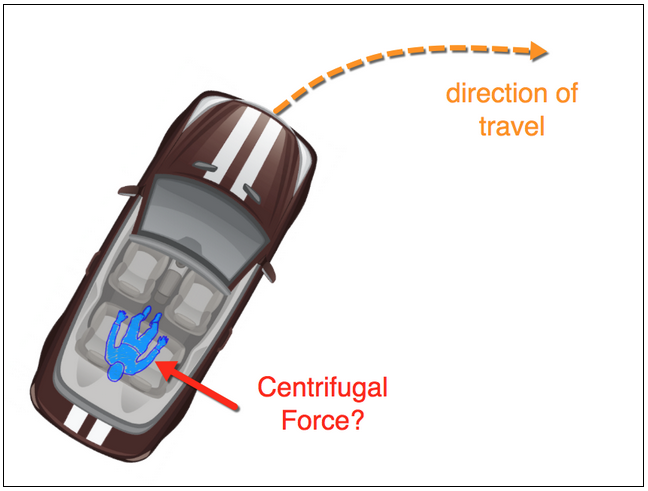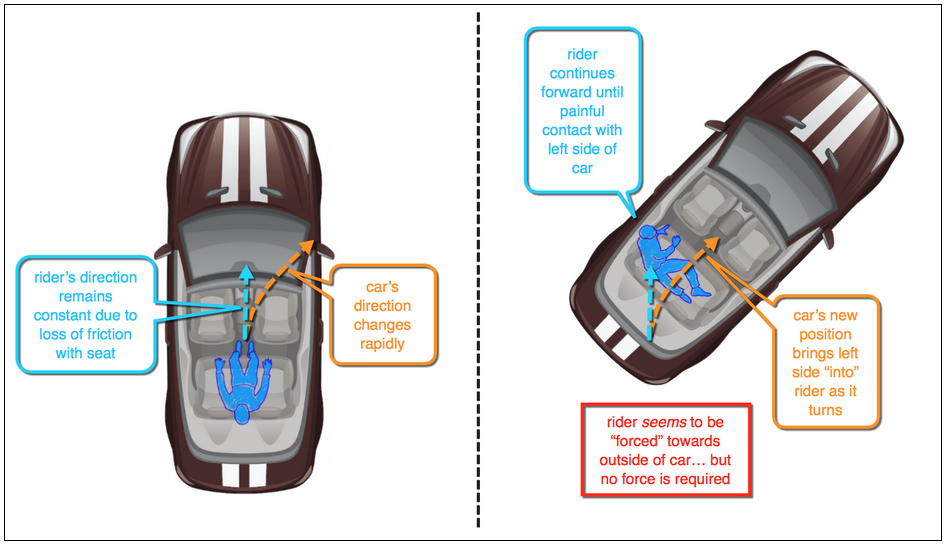
How our intuition about "G-forces" fails us
You’re heading home on a Friday night, sitting in the backseat of your friend’s car, glued to your iPhone as you catch up on the latest Facebook drama. Being a physicist, your friend knows something you don’t. As a joke, your buddy suddenly makes a hard right turn, sending you careening into the cold hard glass of the rear driver-side window, your co-worker’s vacation photos forgotten.
After regaining your balance and plucking your phone out of a crack between the seat and the door you had no idea existed, your first response is, naturally, “What the hell man!?” Your second response? Barely heard between the howls of laughter coming from the front seat:
“Why’d you just send me flying into the door like that?”
This act of “throwing” you into the side of the car is what we like to refer to as centrifugal force. “Pullin’ G’s” as some like to say. It’s the force that pushes your head between your knees on roller coaster loops, and causes fighter pilots to ride the edge of consciousness before blacking out. It’s a familiar feeling we’ve all experienced.
Here’s the kicker though: it doesn’t actually exist. There is no spoon Neo...
Why centrifugal force is a “fictitious force” - violating Newton’s 1st Law of Motion
According to Merriam-Webster, the definition of “centrifugal force” is:
“a force that causes an object moving in a circular path to move out and away from the center of its path.”
Okay, fair enough. Now let’s also think back to high school physics class for a moment and remember Newton’s 1st Law of motion:
“an object either remains at rest or continues to move at a constant velocity, unless acted upon by an external force.”
Alright, so far so good. Forces act on things to make them move differently than they are currently moving, and the centrifugal force is a specific force that moves an object outward during circular motion. Seems reasonable.
So in our case, there must be some force that’s throwing me (rather painfully) against the car door, and that force is called the “centrifugal force.” Got it.
But what happens when we try to sketch it out?

Wait a minute… where is this force coming from?
Is there a wizard in an invisibility cloak next to you, maliciously throwing you into the door?
Has a metal plate been unknowingly installed into your body, and an electromagnet in the door turned on at the exact moment your good friend takes a hard turn?
Is this an as-yet-undiscovered force, missed by Newton, Maxwell, and Einstein that we’re just now discovering!?
Well, to make a long story short (and to save you the trouble of calling the Nobel office to nominate yourself for this incredible discovery), what’s happening here is we’re making a mistake of frame. We’re just too self-centered, failing to consider that the things around us are actually in constant motion (you, the car, the earth, etc.). And our brains are simply doing the best they can to create a sense of stability for us so that we can go about our daily lives.
So what you really should have said to your buddy was:
“Why the hell did you send the car flying into me like that!?”
Sorry what? I think you said that wrong.
Nope.
See, what actually happened is your friend, with his keen sense of relative vehicular motion, knew that if he took that right turn just hard enough while you weren’t paying attention, the back seat of the car (which is of course attached rigidly to the rest of the car) would move out from under you so quickly that you would not have enough time to react and counter-balance yourself by shifting your weight or putting a hand down, breaking the ass-to-seat bond that usually keeps you comfortably seated.
Think of it like stepping onto a treadmill that’s already going 15 mph. Unless you’re already moving with that belt, you’re in for an epic faceplant.
Now the unfortunate part. No longer attached to the car’s structure, you continue at the same trajectory you had when disconnected from the back seat - namely, forward. At the same time, the car continues to make a drastic directional change as your friend keeps turning the wheel, sending the left-side car door towards you at a high rate of speed.

However, as soon as you make contact with Mr. Door, you’re now faithfully connected to the car again, and finish out the turn with it.
Lesson learned: stay on guard in vehicles with physicists at the wheel, and don’t believe every force you feel.
